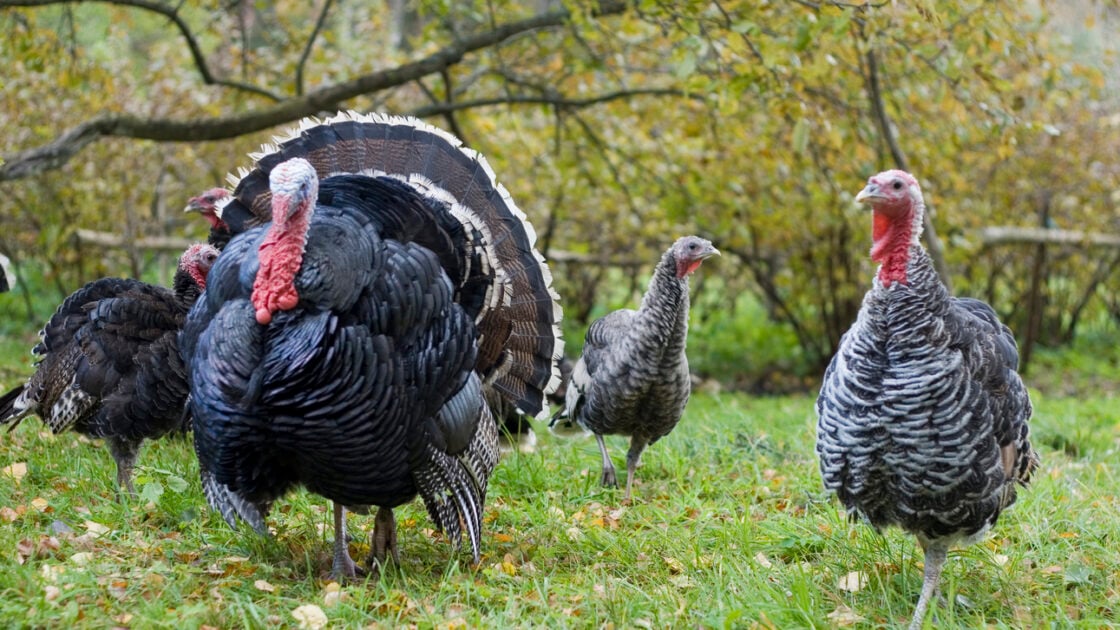6 Lessons I Learned Raising Narragansett Heritage Turkeys

Raising Narragansett turkeys requires patience, persuasion, and a few tricks up your sleeve. I was appointed the lofty title of “Poultry Queen” at Kelmscott Farm in Maine in the winter of 2002. The farm was dedicated to the preservation of endangered livestock breeds, from Cotswold sheep and Poitou asses to Gloucestershire Old Spots pigs.
In addition to many other duties, I was put in charge of our geese, chickens, and Narragansett turkeys. Named after a bay in Rhode Island, the Narragansett is a heritage breed that plumes up like a picture-perfect pilgrims’ turkey. Its dramatic blue-red head and wattle set off its black and white plumage and bronze tail feathers.
The New England Narragansett
Now one of the eight recognized heritage breeds, the Narragansett was once the foundation of New England’s turkey industry. Narragansett turkeys descended from the domestic turkeys brought to the American colonies in the 1600s by English and European settlers (after they had been imported from Mexico to the Old World by sailors a century before). Eventually replaced by factory-farms turkeys like the ubiquitous Broad-Breasted white, Narragansetts are making a comeback on heritage farms.
What I Learned Raising Narragansett Turkeys
When I started as the Poultry Queen, I knew little about Narragansetts or any other type of turkey. With lots of research and hands-on experience, it didn’t take long to learn all about this odd little bird.
- Your Butterball turkey can’t walk. Broad-Breasted Whites are by far the most common type of turkey that you’ll encounter on America’s deli sandwiches and holiday tables. They’re bred in factory farms to have shorter breast bones and abnormally large breasts to accommodate our preferences for white meat. Because of this, Broad-Breasted Whites cannot walk or fly. Most are also unable even to breed without human assistance via artificial insemination.
- Heritage turkeys have more flavorful meat but less of it. Every year I could count on several complaints after the holidays from people who thought that the bird they bought had very little meat. Heritage turkeys actually have a normal amount of meat, but most consumers are just used to the too-fat-to-walk Butterballs.
- Free-range is as free-range does. Our turkeys had daily access to a safe, enclosed yard (we closed it at night in case of predators). Did they go out there? Not in the winter. It was way too cold in Maine. They preferred to huddle together inside and get fed vs. peck around in the freezing wind. Who could blame them?
- Turkeys can be real bastards. We had a few other random heritage turkeys that were red and white, but we could never mix them in the same pen. The larger group would gang up on the little guys and peck at them until they died. This would also happen if one of the Narragansetts became injured or sick. We had to separate them from the others immediately or they would be mercilessly pecked.
- The best way to catch a turkey (or any bird) is to throw a cloth over its head first. No towel handy? A baseball cap will do. This works best if the animal is already in an enclosed space and can’t run away. Bonus: the material cover restrains the turkey from pecking at you.
- Heirloom turkey meat is much more expensive than factory-farmed – about four times as much. Heritage poults (baby turkeys) are very fragile and quite difficult to raise, which adds to the expense. Heat lamps weren’t enough for our poults; we moved them indoors to a fully heated facility and still lost about 25%. Just remember: you’re not only paying for the meat. You’re paying to support small farms and America’s agricultural heritage.
Related on Organic Authority
5 Reasons to Choose a Heritage Turkey This Thanksgiving
7 Vegan Thanksgiving Roasts for Your Holiday Table
Butterball Launches Organic Turkey in Time for Thanksgiving

